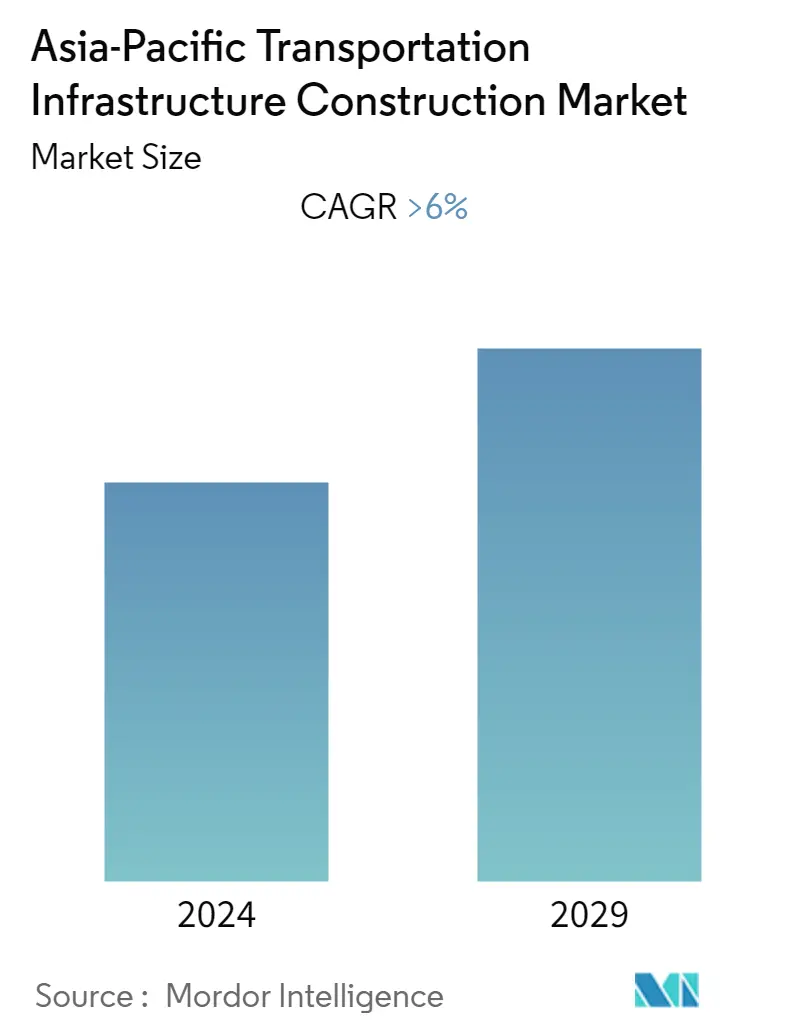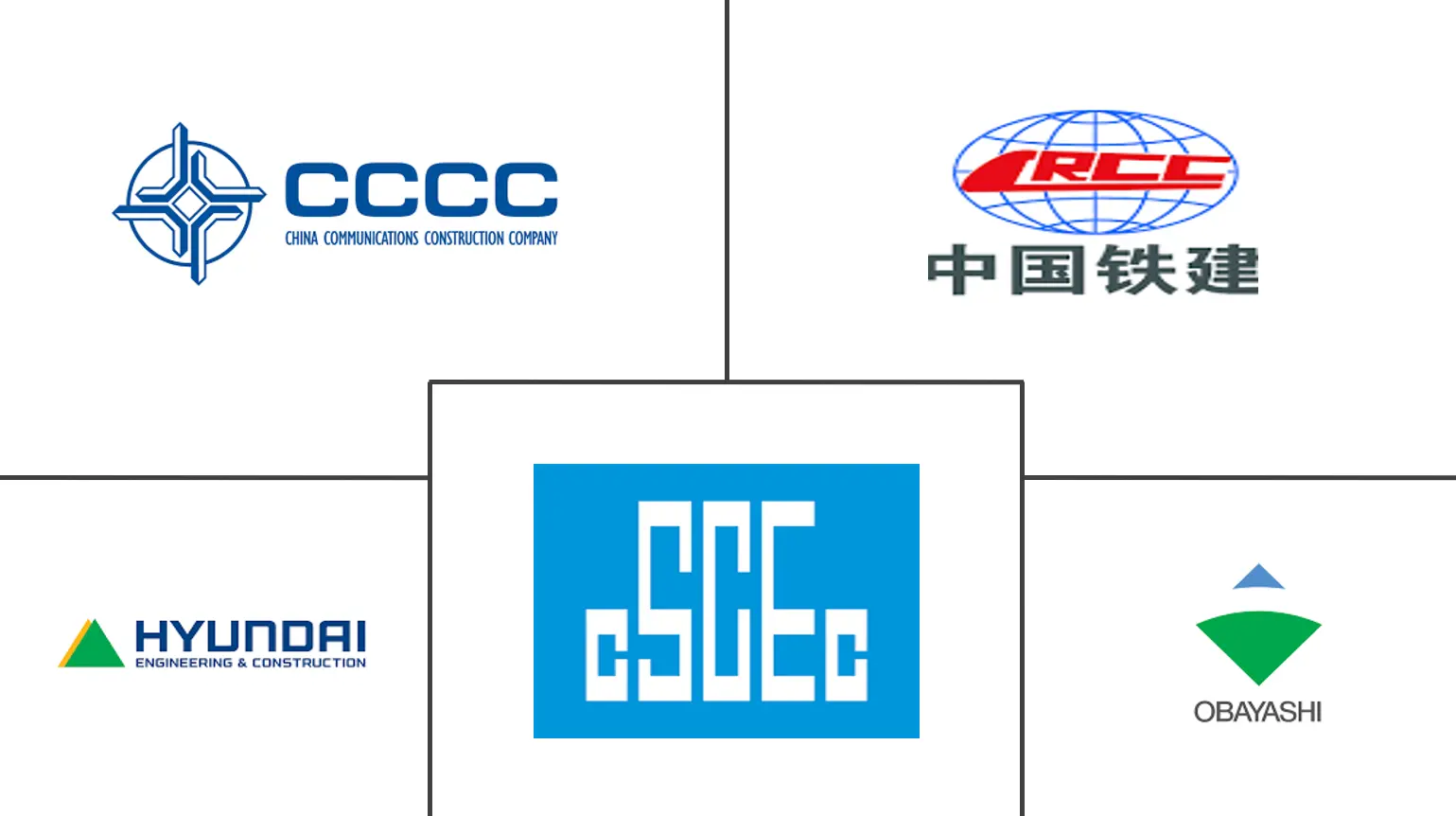Market Size of Asia-Pacific Transportation Infrastructure Construction Industry

| Study Period | 2019 - 2029 |
| Base Year For Estimation | 2023 |
| Forecast Data Period | 2024 - 2029 |
| Historical Data Period | 2019 - 2022 |
| CAGR | 6.00 % |
| Market Concentration | Low |
Major Players
*Disclaimer: Major Players sorted in no particular order |
Asia-Pacific Transportation Infrastructure Construction Market Analysis
The Asia-Pacific transportation infrastructure construction market is anticipated to register a CAGR of more than 6% over the forecast period. The market is driven by huge investments and government initiatives in transportation infrastructure to boost public mobility and the logistics sector. Furthermore, the market is driven by the advancement and digitalization of transport infrastructure to boost the economy.
- Every year, approximately 44 million people are added to Asia's urban population, which equates to 120,000 people per day. In Asian cities, public transportation is the primary mode of transportation. Construction of urban roads alone is not the solution because it encourages a downward spiral of increased purchases and use of private vehicles, resulting in even more congestion. Infrastructure spending may be the most effective way for governments to stimulate their ailing economies. This is because, first and foremost, infrastructure development has a powerful multiplier effect in terms of increasing economic activity and job creation. This means that the overall impact on economic output is greater than the initial spending injection. Second, infrastructure investment is critical for leaving a positive economic legacy of more resilient, sustainable, and productive growth.
- Singapore has anticipated future transportation challenges with a growing population and over 14 million journeys per day and has planned to ensure that the small city-state meets the needs of the population and that the infrastructure is fit for purpose through innovative use of technology and policy decisions. With this in mind, the Land Transport Authority (LTA) is evaluating solutions to build a transportation system capable of dealing with future challenges as well as developing new solutions to improve the current system. The Land Transport Authority (LTA) Master Plan (LTMP) 2040 report summarizes the LTA's long-term plans to construct an efficient, well-connected, inclusive, and fast land transportation system that will meet Singaporeans' needs and aspirations over the next two decades and beyond. Singapore's ambitious metro expansion continues to provide choice contracts for domestic firms and foreign ones with track records in the city-state.
- Logistics is a critical component of India's economic development. Despite its low ranking, India has an advantage in that the majority of its infrastructure network capacity is being built. The logistics sector has seen rapid growth in recent years, which slowed since COVID-19. The Indian government is investing in the development of dedicated rail freight corridors, which will allow freight trains to run on exclusive tracks. The dedicated freight corridors will eventually lower the cost of moving cargo by utilizing larger capacity electric-powered trains. Overall, the government's recent actions and policies appear to be promising for the sector's development.
- China is showing off its transportation skills by building more highways, trains, waterways, and airports in China, Central Asia, and Europe. The Belt and Road Initiative is divided into two parts: a land route connecting China with Southeast Asia, South Asia, Central Asia, Russia, and Europe; and a sea route connecting China's coastal regions with Southeast and South Asia, the South Pacific, the Middle East, and Eastern Africa all the way to Europe. A more convenient logistics network is also under construction. According to Li and Dai, parcels will be delivered to customers in China in one day, to neighboring countries in two days, and to major cities around the world in three days-at least according to plans drawn up by the Ministry of Transportation.
Asia-Pacific Transportation Infrastructure Construction Industry Segmentation
Transportation infrastructure is the system of public works that makes it easier for people to move around.Roads, railways, ports, and airports are all part of it. A complete background analysis of the Asia Pacific Transportation Infrastructure Construction Market, including the assessment of the economy and contribution of sectors in the economy, a market overview, market size estimation for key segments, emerging trends in the market segments, market dynamics and geographical trends, and COVID-19 impact, is covered in the report.
The Asia Pacific Transportation Infrastructure Construction Market is segmented by mode (roads, railways, airways, and waterways) and country (China, India, Vietnam, Japan, South Korea, Indonesia, Thailand, and the Rest of Asia-Pacific). The report offers market size and forecast values (in USD) for all the above segments.
| By Modes | |
| Roads | |
| Railways | |
| Airways | |
| Waterways |
| By Country | |
| China | |
| India | |
| Vietnam | |
| Japan | |
| South Korea | |
| Indonesia | |
| Thailand | |
| Rest of Asia-Pacific |
Asia-Pacific Transportation Infrastructure Construction Market Size Summary
The Asia-Pacific transportation infrastructure construction market is poised for significant growth, driven by substantial investments and government initiatives aimed at enhancing public mobility and the logistics sector. The region's rapid urbanization, with millions added to urban populations annually, underscores the need for robust public transportation systems. Governments are increasingly recognizing infrastructure development as a catalyst for economic stimulation, offering a multiplier effect that boosts economic activity and job creation. This focus on infrastructure is further supported by advancements in technology and digitalization, which are integral to building resilient and sustainable transport systems. Countries like Singapore are proactively addressing future transportation challenges through innovative policies and technological solutions, ensuring their infrastructure meets the evolving needs of their populations.
In India, the government is making significant strides in infrastructure development as part of its vision for a $5 trillion economy, with initiatives like the National Infrastructure Pipeline and the Delhi-Mumbai Industrial Corridor. Despite challenges such as project delays, the commitment to enhancing logistics and transportation networks remains strong. China's ambitious Belt and Road Initiative exemplifies the region's focus on expanding and modernizing transportation links across Asia and beyond. The market is characterized by a mix of local, regional, and global players, with public-private partnerships playing a crucial role in driving growth. As the region navigates demographic, technological, and environmental changes, the transportation infrastructure sector is set to play a pivotal role in supporting economic development and integration.
Asia-Pacific Transportation Infrastructure Construction Market Size - Table of Contents
-
1. MARKET INSIGHTS DYNAMICS
-
1.1 Current Market Scenario
-
1.2 Market Overview
-
1.3 Market Dynamics
-
1.3.1 Drivers
-
1.3.2 Restraints
-
1.3.3 Opportunities
-
-
1.4 Value Chain / Supply Chain Analysis
-
1.5 Porters Five Forces Analysis
-
1.5.1 Threat of New Entrants
-
1.5.2 Bargaining Power of Buyers/Consumers
-
1.5.3 Bargaining Power of Suppliers
-
1.5.4 Threat of Substitute Products
-
1.5.5 Intensity of Competitive Rivalry
-
-
1.6 Industry Policies and Regulations
-
1.7 Technological Developments in the Sector
-
1.8 Industry Attractiveness - Porter's Five Forces Analysis
-
1.9 Impact of COVID - 19 on the Market
-
-
2. MARKET SEGMENTATION
-
2.1 By Modes
-
2.1.1 Roads
-
2.1.2 Railways
-
2.1.3 Airways
-
2.1.4 Waterways
-
-
2.2 By Country
-
2.2.1 China
-
2.2.2 India
-
2.2.3 Vietnam
-
2.2.4 Japan
-
2.2.5 South Korea
-
2.2.6 Indonesia
-
2.2.7 Thailand
-
2.2.8 Rest of Asia-Pacific
-
-
Asia-Pacific Transportation Infrastructure Construction Market Size FAQs
What is the current Asia-Pacific Transportation Infrastructure Construction Market size?
The Asia-Pacific Transportation Infrastructure Construction Market is projected to register a CAGR of greater than 6% during the forecast period (2024-2029)
Who are the key players in Asia-Pacific Transportation Infrastructure Construction Market?
China State Construction Engineering Corporation Ltd., China Railway Construction Corporation, China Communications construction company Ltd., Hyundai Engineering & Construction and OBAYASHI CORPORATION are the major companies operating in the Asia-Pacific Transportation Infrastructure Construction Market.

